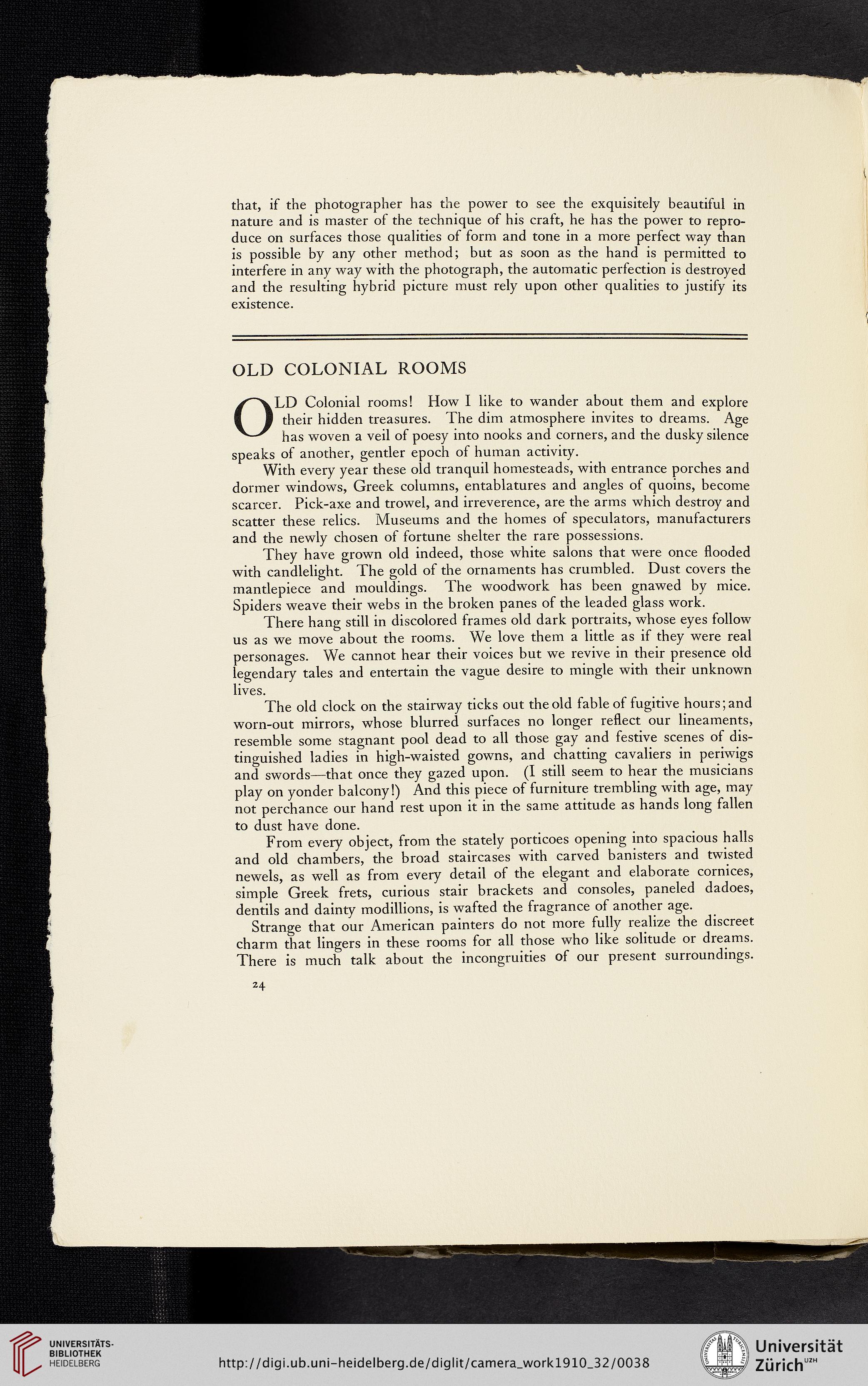Für diese Seite ist auch eine manuell angefertigte Transkription bzw. Edition verfügbar. Bitte wechseln Sie dafür zum Reiter "Transkription" oder "Edition".
that, if the photographer has the power to see the exquisitely beautiful in
nature and is master of the technique of his craft, he has the power to repro-
duce on surfaces those qualities of form and tone in a more perfect way than
is possible by any other method; but as soon as the hand is permitted to
interfere in any way with the photograph, the automatic perfection is destroyed
and the resulting hybrid picture must rely upon other qualities to justify its
existence.
OLD COLONIAL ROOMS
OLD Colonial rooms! How I like to wander about them and explore
their hidden treasures. The dim atmosphere invites to dreams. Age
has woven a veil of poesy into nooks and corners, and the dusky silence
speaks of another, gentler epoch of human activity.
With every year these old tranquil homesteads, with entrance porches and
dormer windows, Greek columns, entablatures and angles of quoins, become
scarcer. Pick-axe and trowel, and irreverence, are the arms which destroy and
scatter these relics. Museums and the homes of speculators, manufacturers
and the newly chosen of fortune shelter the rare possessions.
They have grown old indeed, those white salons that were once flooded
with candlelight. The gold of the ornaments has crumbled. Dust covers the
mantlepiece and mouldings. The woodwork has been gnawed by mice.
Spiders weave their webs in the broken panes of the leaded glass work.
There hang still in discolored frames old dark portraits, whose eyes follow
us as we move about the rooms. We love them a little as if they were real
personages. We cannot hear their voices but we revive in their presence old
legendary tales and entertain the vague desire to mingle with their unknown
lives.
The old clock on the stairway ticks out the old fable of fugitive hours; and
worn-out mirrors, whose blurred surfaces no longer reflect our lineaments,
resemble some stagnant pool dead to all those gay and festive scenes of dis-
tinguished ladies in high-waisted gowns, and chatting cavaliers in periwigs
and swords—that once they gazed upon. (I still seem to hear the musicians
play on yonder balcony!) And this piece of furniture trembling with age, may
not perchance our hand rest upon it in the same attitude as hands long fallen
to dust have done.
From every object, from the stately porticoes opening into spacious halls
and old chambers, the broad staircases with carved banisters and twisted
newels, as well as from every detail of the elegant and elaborate cornices,
simple Greek frets, curious stair brackets and consoles, paneled dadoes,
dentils and dainty modillions, is wafted the fragrance of another age.
Strange that our American painters do not more fully realize the discreet
charm that lingers in these rooms for all those who like solitude or dreams.
There is much talk about the incongruities of our present surroundings.
24
nature and is master of the technique of his craft, he has the power to repro-
duce on surfaces those qualities of form and tone in a more perfect way than
is possible by any other method; but as soon as the hand is permitted to
interfere in any way with the photograph, the automatic perfection is destroyed
and the resulting hybrid picture must rely upon other qualities to justify its
existence.
OLD COLONIAL ROOMS
OLD Colonial rooms! How I like to wander about them and explore
their hidden treasures. The dim atmosphere invites to dreams. Age
has woven a veil of poesy into nooks and corners, and the dusky silence
speaks of another, gentler epoch of human activity.
With every year these old tranquil homesteads, with entrance porches and
dormer windows, Greek columns, entablatures and angles of quoins, become
scarcer. Pick-axe and trowel, and irreverence, are the arms which destroy and
scatter these relics. Museums and the homes of speculators, manufacturers
and the newly chosen of fortune shelter the rare possessions.
They have grown old indeed, those white salons that were once flooded
with candlelight. The gold of the ornaments has crumbled. Dust covers the
mantlepiece and mouldings. The woodwork has been gnawed by mice.
Spiders weave their webs in the broken panes of the leaded glass work.
There hang still in discolored frames old dark portraits, whose eyes follow
us as we move about the rooms. We love them a little as if they were real
personages. We cannot hear their voices but we revive in their presence old
legendary tales and entertain the vague desire to mingle with their unknown
lives.
The old clock on the stairway ticks out the old fable of fugitive hours; and
worn-out mirrors, whose blurred surfaces no longer reflect our lineaments,
resemble some stagnant pool dead to all those gay and festive scenes of dis-
tinguished ladies in high-waisted gowns, and chatting cavaliers in periwigs
and swords—that once they gazed upon. (I still seem to hear the musicians
play on yonder balcony!) And this piece of furniture trembling with age, may
not perchance our hand rest upon it in the same attitude as hands long fallen
to dust have done.
From every object, from the stately porticoes opening into spacious halls
and old chambers, the broad staircases with carved banisters and twisted
newels, as well as from every detail of the elegant and elaborate cornices,
simple Greek frets, curious stair brackets and consoles, paneled dadoes,
dentils and dainty modillions, is wafted the fragrance of another age.
Strange that our American painters do not more fully realize the discreet
charm that lingers in these rooms for all those who like solitude or dreams.
There is much talk about the incongruities of our present surroundings.
24



